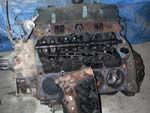
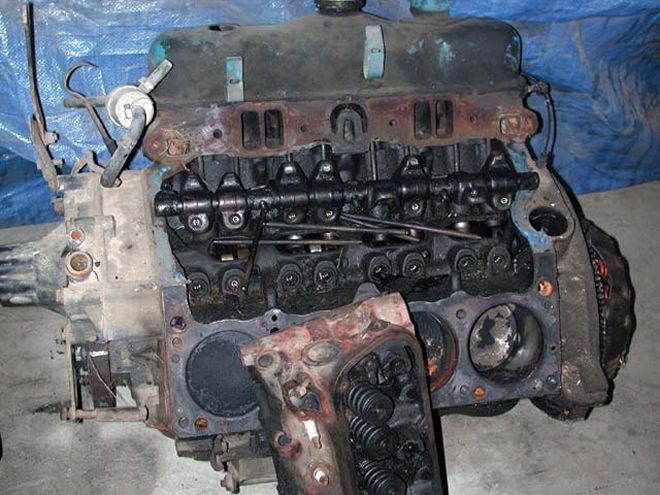 01. What's a guy to do if this is all that's left of the"seasoned" 318 engine he just pulled and disassembled? Follow along and find out.
01. What's a guy to do if this is all that's left of the"seasoned" 318 engine he just pulled and disassembled? Follow along and find out.
We got the call late one Tuesday night. Our buddy Buzz had picked up his freshly Recon-remanufactured long-block at his local Pep Boys. We could tell he was excited yet somewhat apprehensive. A fresh engine, nearly ready to run, can be had from Manny, Moe, and Jack. Anyone could dig on that convenience, and Buzz was eager to just open the crate and ease the assembly into his truck. "Wait a minute there, Buzz," we said. "A little wrenching is still required before it can go in. A long-block is a bare short-block with heads and a valvetrain installed. The engine will need to be tinned-up with valve covers and the oil pan, and then the oil pump and pickup need to go on. Up front, the timing-case cover needs fitting, as does the damper and water pump. Then the top end needs completion with an intake and carb."
Fortunately, most of these components can be skinned off the expired mill, but we had to wonder if that was going to be good enough for Buzz.
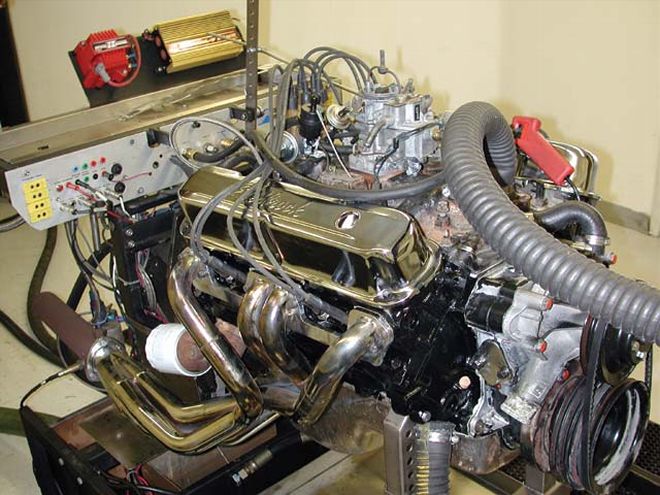 02. Our 318 test engine was assembled from an out-of-the-box, remanufactured long-block from Recon. It was dressed to kill (well, maybe just wing 'em a little) with mostly take-off parts from the 318 it was meant to replace.
02. Our 318 test engine was assembled from an out-of-the-box, remanufactured long-block from Recon. It was dressed to kill (well, maybe just wing 'em a little) with mostly take-off parts from the 318 it was meant to replace.
The original engine being replaced was a plain 318 two-barrel, an unassailable combination for its thrift and reliability, although not inspiring in terms of performance. We choked at the mere thought of topping the engine with the same old two-barrel and iron 2V intake, and the notion of attaching the iron log exhaust manifolds had us in convulsions.
"Buzz," we suggested, "while you have the wrenches out, let's step it up a little and see if we can't coax some more power out of the combo. Just clean up the old tin, bring the crate over to Westech, and we'll do the rest by Friday."
Our plan was nothing overly ambitious. We just wanted to apply the time-proven steps we like to call "the first level of hot-rodding" to the basic Recon package. Of course, topping the assembly with a four-barrel induction system on the inlet side of the heads was part of the plan. We felt this selection was infinitely more acceptable than the stock 2V intake and carb. On the exit flange of the cylinder heads, we would employ traditional four-into-one tube headers, which promised improved aesthetics and breathing capabilities. We could have stopped there, but the prospect of a camshaft change was too tempting to neglect.
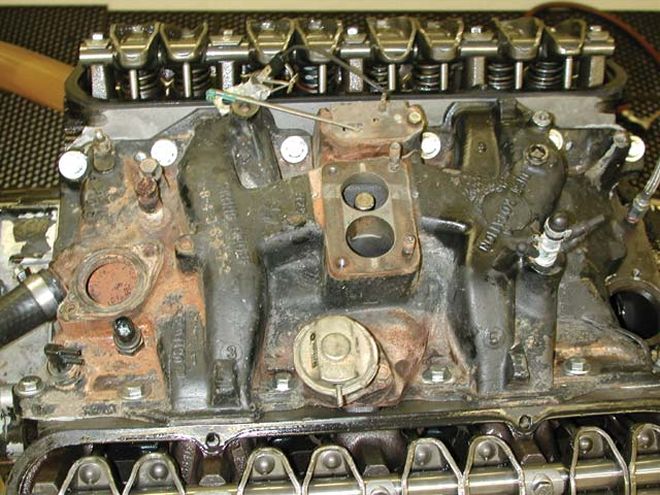 03. We cringed at the thought of bolting up the stock two-barrel intake, but on it went for our baseline testing. It wasn't a pretty sight.
03. We cringed at the thought of bolting up the stock two-barrel intake, but on it went for our baseline testing. It wasn't a pretty sight.
Restraint is the watchword when considering a camshaft upgrade in an otherwise internally stock 318. The restraining factors include a relatively low compression ratio, as well as conservative valve and port dimensions. These constraints will limit the potential of an overly enthusiastic camshaft choice at two levels. With the modest compression ratio, an excessive level of camshaft duration will tend to diminish cylinder pressure, particularly at the engine's operating rpm. What's the result? Expect an unacceptable drop in torque over the same useable rpm range. Relative to the small-port/small-valve configuration of the stock 318 heads, the power-making potential of high levels of valve lift is essentially negated by the limited high-lift flow. Still, the constrained valve motion delivered by the stock camshaft left a great deal of room to the upside.
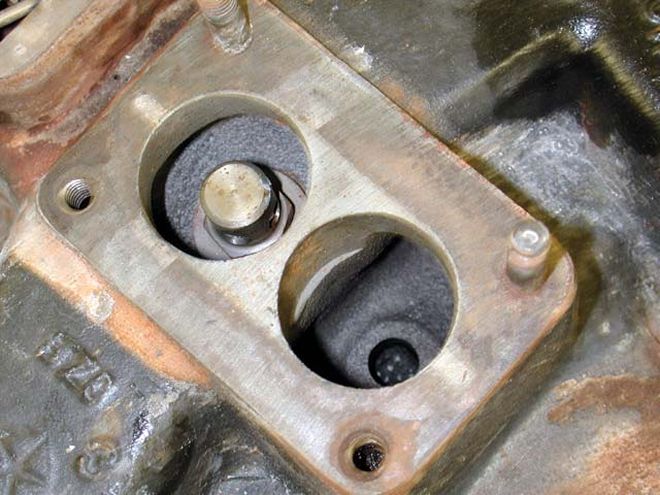 04. Looking down the spout of the factory two-barrel intake's carb flange, you can see this late-model manifold is further choked by the large EGR fitting in the plenum. Not only does this intake not scream performance, but it also has a hard time even mentioning it.
04. Looking down the spout of the factory two-barrel intake's carb flange, you can see this late-model manifold is further choked by the large EGR fitting in the plenum. Not only does this intake not scream performance, but it also has a hard time even mentioning it.
We elected to go with a Competition Cams XE262H, a hydraulic grind spec'ing out with a gross duration of 262/270, delivering 218/224 degrees open time at .050 inch tappet rise and .462/.470 inch lift on the intake and exhaust sides, respectively. Another good choice would have been Comp's smaller XE 256H, which shows a somewhat fatter torque curve down low. Higher camshaft should be reserved for combinations with more flow potential from the cylinder heads and a higher level of static compression.
SPINNIN' UP
We weren't expecting to transform Buzz's 318 into a drag mill. But we were confident we'd find a meaningful increase in output from our simple formula. To this end, we scraped the grease and grime off the stock components, completed the engine assembly, and made our way to Westech's dyno facility to obtain a baseline with the stock 318. Dyno operator Steve Brule greeted us at the door, and we couldn't help but feel a little inadequate as he surveyed our humble small-block. "Whatcha got here, Dulcich?" he asked, clearly unimpressed by the factory iron and tiny two-barrel carb. We explained our scheme was to add power-enhancing components and see just what they contribute to the output of a remanufactured 318. It wasn't exactly the high-end testing Brule is accustomed to, but he agreed to proceed.
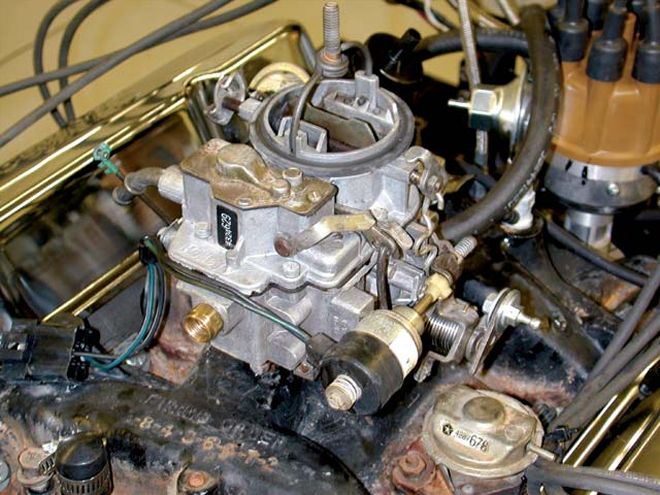 05. Topping the intake, a factory Holley two-barrel mixes the fuel with whatever air can squeeze through its venturi.
05. Topping the intake, a factory Holley two-barrel mixes the fuel with whatever air can squeeze through its venturi.
Though our intention was to run the baseline with factory iron exhaust, we ran into a glitch when we found the manifold exits dumped directly onto the dyno chassis. We needed to run headers for all our tests, arguably enhancing the baseline numbers over what could be expected in a true stock configuration. We bolted on our favorite set of TTI 15/8-13/4-inch stepped small-block headers and a Mopar Performance electronic ignition distributor. We filled the crankcase with 10/30 motor oil, and we were ready to run. The engine was set for 34 degrees of total timing, fired, and run through an automated break-in cycle on the SuperFlow dyno. The 318 idled with 20 inches of manifold vacuum. It idled so smoothly that, despite open headers, it was impossible to detect the engine was running over the sound of the dyno fans. We gingerly shook Mr. Brule by the shoulders, thoughtlessly awakening him from a peaceful slumber at the dyno control console. We were ready for our first power pulls.
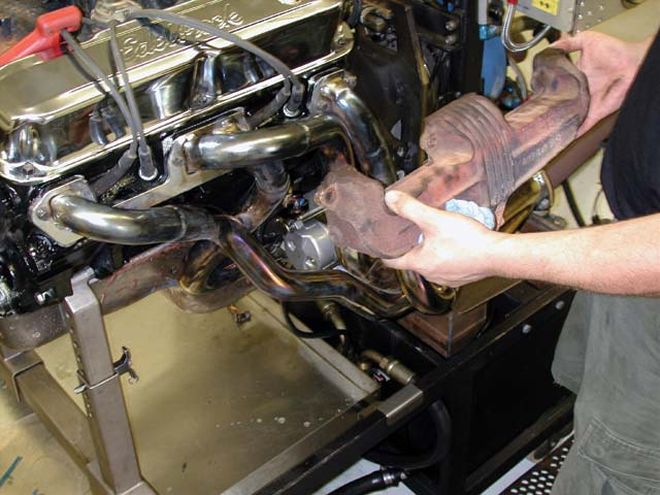 06. To arrive at the baseline power figures, we had planned on running the factory-iron truck exhaust manifolds. But, a lack of head pipes meant the exhaust would exit unfavorably onto the dyno chassis. We bolted on our TTI test headers for the baseline tests, which we're sure added to the baseline output.
06. To arrive at the baseline power figures, we had planned on running the factory-iron truck exhaust manifolds. But, a lack of head pipes meant the exhaust would exit unfavorably onto the dyno chassis. We bolted on our TTI test headers for the baseline tests, which we're sure added to the baseline output.
Trouble reared its ugly head, and our 318 wheezed out a sputtering climb partially up the rev range before the attempt was summarily aborted. Brule studied the output readout and noted the MECP numbers were way out of line, even for a stock engine. He glanced over and the look in his eyes clearly said, "You go fix it." It was ignition related, and we were sure the electronics were sound. The reluctor gap was reset, a cursory check was made of rotor phasing, timing was confirmed on the damper, and we tried again. A couple hundred rpm into the pull, Brule shut it down. It wasn't fixed. On a hunch, I slacked the distributor clamp, gave the distributor a good twist clockwise, nipped it up, and asked him to try it again. Paydirt! The engine pulled cleanly, making 283 lb-ft of torque and 178 hp. It was just about right for a 318 two-barrel. The MECP and BSFC numbers recorded by the dyno were back in line, confirming that the problem was solved.
"What's the timing?" asked Brule. "Oh, a good twist back from where it was," we replied. A check on the damper showed 25 degrees BTDC. The used 318 damper was junk. Its outer ring had spun out of position. We continued, zeroing in on the required timing through a trial-and-error timing loop until optimal output was achieved. Max for the stock 318 with headers was 189 hp at 4,100-4,200 rpm and 292 lb-ft of torque at 2,000 rpm (the lowest recorded engine speed). Unfortunately, with the spun damper, we are unable to report on the true timing. But, usually, 34-36 degrees total will be close.
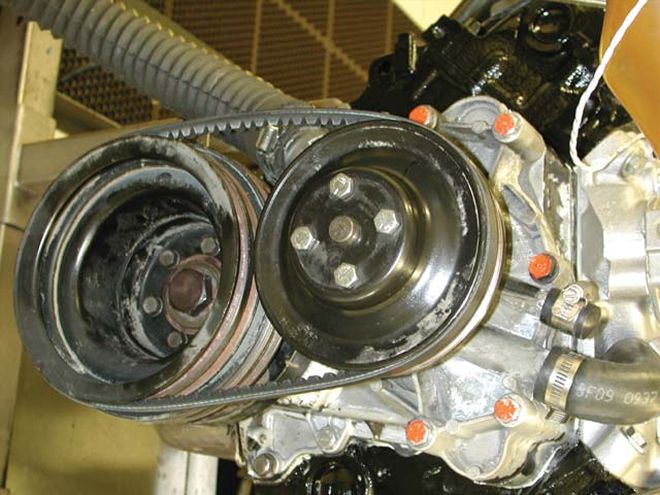 07. The stock pulleys were retained throughout the test session.
07. The stock pulleys were retained throughout the test session.
POWER PARTS
Normally, when considering an upgrade sequence for testing, we upgrade parts one component at a time. In this case, we elected to perform all the modifications at once. Headers were already fitted to the engine, leaving only the induction and cam upgrades. Clearly, running the hotter cam combo with the stock induction would be pointless. We felt the induction change would be compromised by the conservative timing of the camshaft. This would understate the benefit of the manifold and carb combo. The most sensible approach in this case would be to upgrade with a complementary induction and cam combo and report on the results accordingly.
The engine was stripped for a cam change. This required the removal of the valve covers, intake manifold, and valvetrain up top. Also, the water pump, damper, and timing case up front were removed. The Comp XE 262H camshaft was installed along with new Comp PN 822-16 lifters. We noted that the Recon long-block was delivered with single-wound valvesprings with a damper coil--a typical first-level, performance-type spring. We determined these springs would be adequate for the camshaft selected. The stock valvetrain was retained and the engine was reassembled.
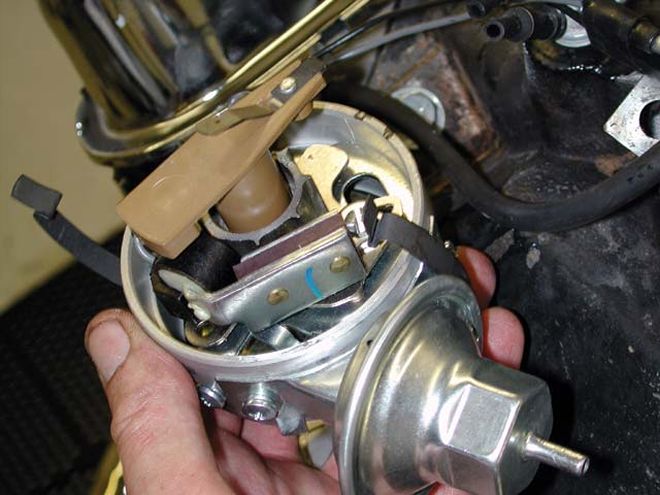 08. A Mopar Performance electronic ignition distributor was tied into the dyno's ignition system and provided the spark.
08. A Mopar Performance electronic ignition distributor was tied into the dyno's ignition system and provided the spark.
Intake-manifold selection for the 318 is limited compared to the choices available for the 340 or 360 engines. With the exception of 318 four-barrels, which share the cylinder heads with the 360 engine, 318s were equipped with small-port heads. Of the intakes produced today, the best matches we've found for the 318 port size are Edelbrock's standard Performer and Mopar Performance's M-1 two-plane. We wouldn't consider anything but a two-plane intake for a mild 318 with stock heads, because a single-plane will sacrifice significant levels of torque output for no real gains higher in the rpm range. With a 318, torque is too valuable a commodity to just throw away. We went with Mopar's M-1 and topped it with an Edelbrock 600-cfm, AFB-style carburetor. With the induction selection made, our 318 was buttoned up and we were set for another turn on the dyno.
With the changes in configuration, the 318 retained good idle characteristics. However, vacuum dropped to 15-16 inches Hg at idle. The 318 sounded stronger as the engine was run for the cam break-in procedure. Dropping to idle speed scarcely produced an audible lope. We set the timing to the same setting previously found to be optimal and pulled the engine against the SuperFlow brake. Output surged to 272 hp at 5,100 rpm and 338 lb-ft at 3,000 rpm (the bottom of our pull range). Right out of the chute, power was up by 83 hp, with a 55 lb-ft increase in torque--not a bad gain with only a cam and induction change. We could tell the fuel mixture was a little fat with the Edelbrock carb, which meant we had the potential to make more power with a little mixture tuning. Unfortunately, we were short the required jets to tune the AFB carb. We wanted to further explore the power potential of this combo, so we decided to change the carb to a 650 Demon, for which we had a vast assortment of jets.
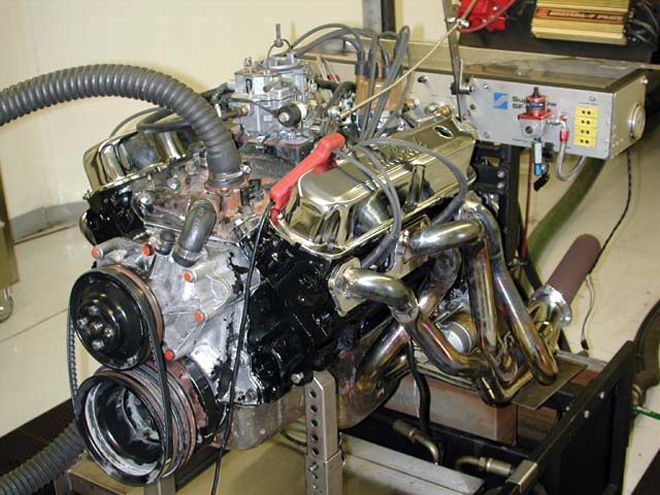 09. In stock form with headers handling the exhaust, the low-compression, small-valved 318 pulled 189 hp and 292 lb-ft of torque. While it's not bad for a stocker, it's not enough to put the competition on notice.
09. In stock form with headers handling the exhaust, the low-compression, small-valved 318 pulled 189 hp and 292 lb-ft of torque. While it's not bad for a stocker, it's not enough to put the competition on notice.
Fitting the Demon carb to the M-1 intake required a 1-inch spacer to allow the linkage to clear the manifold mounting surface, so a BG spacer was added at this time. Adding a spacer to a two-plane manifold will typically result in the torque curve shifting slightly upward, enhancing the top end of the power curve at the expense of some lower-end power. We made the swap and set about zeroing in on the optimal jetting, and indeed found power. In this case, the sharper jetting overrode most of the torque penalty expected by the presence of the spacer. We found a minimal loss at the bottom of our test range, while predictably enhancing top-end output. Our 318 now produced 282 hp at 5,000 rpm, and 340 lb-ft of torque at 3,600.
We were pleased with the results of our experiment with the 318. A quick calculation showed that the output of our Recon remanufactured test engine was enhanced to the tune of 93 hp by an intake, carb, and cam change. If we had begun with the stock iron exhaust manifolds, the gains would have registered well over 100 hp. While just the raw numbers are a substantial gain (considering the baseline output of some 189 hp), the changes raised the engine output by a staggering 55 percent. While 282 hp isn't going to get a horsepower freak like Brule wild with excitement, it's enough to feel a real difference compared to your stock 318.
TORQUE SUPERFLOW 901 DYNO-TESTED AT WESTECHRPMBASEMOD 1MOD 22,0002922,5002873,0002873383363,5002723353404,00024832633045002183093195,0001882852965,500250258 HORSEPOWER SUPERFLOW 901 DYNO-TESTED AT WESTECHRPMBASEMOD 1MOD 21122,5001373,000{{{164}}}1931923,5001822242274,0001892482524,5001862652745,0001792712825,500262270